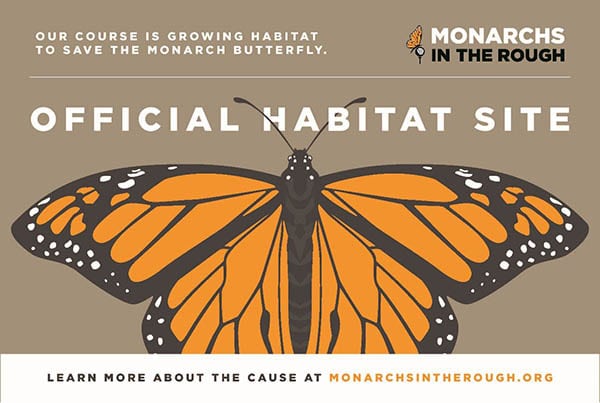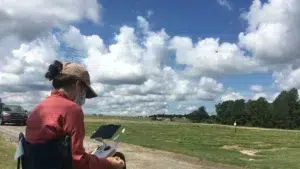Pollinator habitat creation builds unique partnerships.
Efforts to expand pollinator habitats on farms have brought about thousands of acres of forage for bees and butterflies. But, pollinators don’t just live on farms. Suburban and even urban areas provide valuable landscape opportunities that might otherwise be overlooked. And the need is still there.
Monarch butterflies have seen a 90 percent decline, while butterflies in general have seen a 40 percent decline.
So, while beekeepers, agribusinesses and conservation groups continue to lead pollinator stewardship efforts, individuals in various niche disciplines, such as golf course superintendents, commercial farmers and ag retailers, are also jumping in, with great success.
Christine Kane, executive director of Audubon International, has seen pollinator projects bring people together in new ways. “Our ability to focus on golf courses has involved a whole new sector in the pollinator discussion,” she says.
Audubon International’s mission is to provide high-quality environmental education to facilitate the sustainable management of land, water, wildlife and other natural resources in all places people live, work and play. They are uniquely positioned to support pollinator habitat creation on golf courses.
Audubon International and the Environmental Defense Fund have teamed up with North America’s golf courses to reverse the decline with their Monarchs in the Rough program.
In the United States alone, there are approximately 15,000 golf courses. According to Marcus Gray, director of Audubon International’s Cooperative Sanctuary Program, about 26 percent of the property owned by golf courses is comprised of natural areas and available for habitat projects. Creating pollinator habitat in these out-of-play areas is ideal because they are typically insulated from pesticide applications that might be used on the greens.
“We’ve been really excited about the level of participation. The Monarchs in the Rough program is specifically focused on creating new habitat for monarchs, but we also know these plantings will benefit other pollinators as well,” Kane says.
A Natural Next Step
“These partnerships may be unconventional, but they are not unexpected,” says Walt Osborne, key account manager,golf, Syngenta Turf & Landscape.
In fact, from the superintendent’s perspective, managing a golf course is similar to managing a farm. It’s their job to be good stewards of the land while balancing a budget, environmental conditions and the needs of the organization.
“They are there to manage the turf and all the landscaping, and Operation Pollinator caught their attention as something more they could be doing to make a difference,” Osborne says.
It is more work, but there are significant benefits.
“Superintendents are very busy, but they have made the effort to add an additional project to their worklist, because they believe in the mission,” Osborne says.
The effort began through research at the University of Kentucky and six original course sites were created. Those superintendents shared what they were doing, and now the program has really grown with more than 250 sites now involved.
“These superintendents have a strong network amongst themselves and were able to share the idea,” Osborne says. The goal is to create valuable new habitats in out of play areas of golf courses, and the response has been great so far.
“One of the keys to that success has been involving the management team from the beginning. This has worked best when the superintendent has communicated with the front office early on,” Osborne says.
The only pushback has been in regard to signage, but even that is uncommon.
“We had one club that didn’t want the Operation Pollinator signage on the course, but the plot is still there doing its job,” Osborne says.
Adding hives for honeybees elevates the participation even more. In one case, the superintendent involved the food and beverage management by providing honey for drinks in the lounge.
“It gives the project an immediate boost and engages the entire organization
from the beginning, which leads to excitement and support,” Osborne says.
Training Beyond Turf
Osborne says while course management teams are highly skilled at dealing with turf, native plants, wildflowers and other habitat species can be tricky to get the hang of because they are so different.
“There is a learning curve. It’s a new growing environment. But from what I’ve seen firsthand, these guys do not avoid the challenge. They are growers and shifting their areas of expertise to manage these plots differently, and they are doing a good job,” Osborne says.
In many cases, what starts as a challenge, ends up becoming a hobby.
“They are just good at growing, and this fits right into that,” Osborne says.
Gray says there are studies coming out of Florida that show pollinators can even encourage beneficial insects that actually help control turf pests.
“We’re all learning that creating a habitat has a lot more benefits and larger impacts than just looking nice on the course,” Gray says.
The Right Mix
Osborne says the right seed mix goes a long way toward ensuring success of a project.
Gray agrees. “There have been some programs that have taken a more cookie-cutter approach to planting, but some varieties are difficult to grow in parts of the country,” he says.
Milkweed, especially, can be difficult to grow in parts of the desert southwest, or in the wetlands of Florida, so it’s important to use the right seed. And, there are sometimes even seed shortages.
It’s also important to manage expectations. “We want them to know this isn’t just a one-time thing. It’s a long-term commitment,” Gray says.
Osborne agrees some coaching on the front end is important, so everyone is clear on the commitment, the goal, and the expectations. “We want to make sure they understand the purpose of the project. Managing a habitat isn’t an overwhelming burden or anything, but it’s important to manage those expectations from the beginning so we can help them be successful,” he says.
Education Opportunities
Local students are also benefiting.
“There have been a number of cases where they have involved the local grade schools and invited them the golf course to see the plot and pollinators at work. They get a better idea how to be good stewards of the land,” Osborne says.
At sites with hives, this is even more exciting. “Some of these superintendents have started beekeeping, or are working with local beekeepers, and it’s great when students can come see those hives, or even decorate the hives and really be involved in the project,” Osborne says. “It’s great when we see kids out there. They just really enjoy learning in this environment.”
Growing Beyond the Greens
As Operation Pollinator grows, Osborne would like to see more habitat plots outside the traditional farm setting, and he thinks golf courses are just the beginning.
“We are starting to interact with some utility companies to see about the possibility of managing that space as a habitat. It helps them with the land management aspect and provides some positive public relations opportunities,” Osborne says.
Solar farms are another spot where Osborne would like to see more habitat creation, and he’d like to see more cities and municipalities get involved.
“Working with parks departments can have an impact both on educating the community and supporting the health of native pollinators,” Osborne says.
Stories about these off-farm projects mostly spread by word of mouth, especially online.
Osborne used to be hesitant of social media, but he has seen the positive effect it has had in spreading the word about pollinator habitat projects.
“When utilized properly, it can play a large role,” he says.
Still, there are challenges.
“We are lucky the buy-in isn’t a challenge because there are not a lot of grants for natural resources protection on golf courses like there are for farms. The sector has not been included in a lot of conversations, and these clubs foot the bill,” Gray says. “If courses weren’t supplying resources, these projects would be impossible to maintain long term. However, you don’t have to be too inventive with water quality projects to see how riparian buffers and rain gardens can benefit pollinators.”
Kane is hopeful there will be more government support in the future, but he isn’t willing to wait.
“There is a push for different agencies to promote pollinator initiatives that communities could potentially tap into, but we aren’t going to wait for government funding. We’re working on this now,” she says.
Gray is excited about the future as more groups begin to participate in pollinator efforts and new alliances are formed.
“We’re building an exciting coalition with different groups participating as we try to broaden the discussion to a more comprehensive landscape approach.
“It’s interesting and rewarding to get them to think about expanding those efforts into more suburban and even urban settings to complement that work,” he says.












